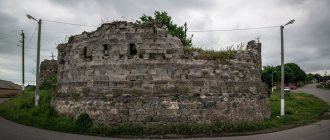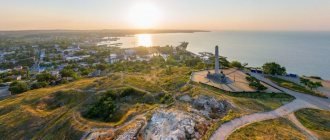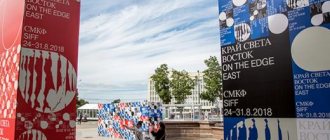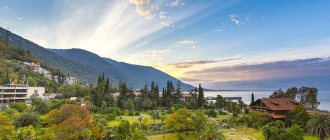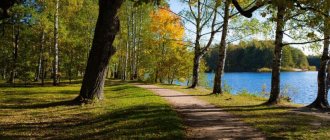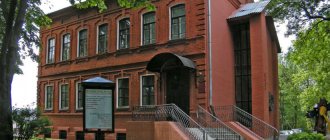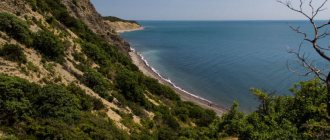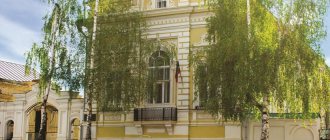Of course, the sights of Yalta are the main treasury of interesting places throughout Crimea. On the territory of the urban district, located in the most elite part of the South Coast, tourists have been prepared for what hundreds of thousands of guests flock to the peninsula every year. Visit Yalta and visit the notorious palaces of the South Coast, the delightful Nikitsky Botanical Garden, the unique embankment named after. Lenin and the majestic Ai-Petri are a must-see for everyone who comes here. We will try to tell you about all the business cards of the city of Yalta, so that you know exactly what to see here first.
Might be interesting:
Evpatoria
Balaclava
Alushta
Gurzuf
all cities
Massandra Palace
This is another former imperial property, originally belonging to Alexander III. True, the last of the Russian autocrats, Nicholas II, rarely visited the Massandra Palace. But there are always a lot of tourists here and there are places to go.
The palace is located in Upper Massandra. Here, far from the noisy center of Yalta, you can independently find housing in the private sector, which promises the tourist a relaxing holiday and savings, because with this method of accommodation no intermediaries are needed.
The cost of a single ticket to all exhibitions is 550 rubles. It will take no more than an hour to explore the palace. On weekdays, access here closes at 6 pm, and on weekends – 2 hours later.
An adult ticket for the main excursion costs 350 rubles. Children, students and pensioners enjoy a discounted rate of 200 rubles.
ъ
Interesting! What to do in Dombay in winter if you don’t know how to ride
Geography and climate
Yalta is located on the shore of the Black Sea bay of the same name in the south of the Crimean Peninsula. The city is located in the valleys of two small rivers Derekoyka and Uchan-Su on the hills surrounded by the Crimean mountains. In the north-west stretches the Yalta yayla with the peak of Kemal-Egerek (1530 m), and in the south there is the picturesque Ai-Petri (1234 m).
Yalta has a warm Mediterranean climate and is located at the same latitude as Italian Genoa. The resort climate is characterized by hot summers, mild winters, and long and warm autumns. At the height of summer, the water temperature in Yalta warms up to 26 - 28 °C. The resort is also famous for its many natural parks and green areas with introduced plant species, among which the Vorontsovsky and Livadia parks stand out.
Yalta
Swallow's Nest (Gaspra village)
One of the most recognizable places on the entire Crimean peninsula, which is popular among tourists in autumn, spring and summer. The Gothic castle, which somehow miraculously found itself on the edge of a high cliff, flaunts on many tourist photos and in all guidebooks to Crimea. The walking path to it lies along a half-kilometer staircase. You can also get to the castle by sea. Tourist ships run directly to its entrance every half hour. You will have to spend a little less than an hour and 600 rubles on the road there and back.
The tour lasts approximately 40 minutes. This is enough to take a photo and look around the castle inside and out. But if nothing special can be said about the interior decoration of the palace, the views from the top of the cliff awaken a lot of enthusiastic emotions in tourists. The Wishing Tree grows not far from the castle. Instead of leaves, it is full of thousands of bows, which are sold nearby and tied by tourists to the branches in the name of making their deepest dreams come true.
In addition to excursions, other cultural events are held here, such as the Evening at the Castle program. Literary readings, performances and concerts are held here in the open area.
For an adult ticket you need to pay 200 rubles, a child ticket costs half as much.
Beaches of Yalta
- Primorsky beach is the central beach of Yalta, small pebbles. It is short in length (about 500 meters). Equipped with all necessary infrastructure.
- Massandra Beach is another famous beach in the center of Yalta, approximately 500 m long. It is divided into several zones and has a “Blue Flag” (a blue flag is an international award indicating that a beach meets high standards).
- The beach near the Intourist hotel is a good pebble beach with a Blue Flag. Paid for vacationers who are not guests of the hotel of the same name.
- Golden Beach, located 8 km from Yalta near the Kurpaty sanatorium.
- Nikitsky Beach is a small secluded beach 7 km from the city center.
- Dolphin Beach is a free beach in the village of Livadia, 3 km from the center of Yalta.
Shopping
Shopping in Yalta is quite an expensive pleasure . The cost of goods, according to vacationers, is greatly inflated.
Confetti
Shopping center "Confetti" is located at st. Bolshevikskaya, 10 . It includes branded boutiques and a gallery of clothing and shoes, supermarkets for household appliances and electronics, and a food supermarket.
Fountain
The Fountain shopping center in the city center offers its visitors to purchase fashionable clothes, cosmetics, and souvenirs. The complex is located on Lenin Embankment, 5a .
Ray
The trade and office area includes clothing, footwear and electronics stores. The complex is located at st. Kievskaya, 24b .
Story
The environs of Yalta were inhabited in ancient times by the Tauri, the indigenous people of Crimea. It is believed that the first settlement here was founded by the Greeks in Antiquity. The modern name of the city most likely comes from the Greek "Yalita", which means "coastal".
The founding date of Yalta is considered to be 1154, when in the Middle Ages a settlement was founded here by merchants from Venice, who were then replaced by the Genoese. In the second half of the 15th century, Yalta was captured by the Turks and included in the Ottoman Empire. Then the settlement was part of the Crimean Khanate.
Yachts. Yalta
In 1783, Crimea was annexed to the Russian Empire. Yalta was a small fishing village. Everything changed under Governor-General Vorontsov, who distributed land here, on which the nobles began to build luxurious estates. In 1838, Yalta received city status. After the Crimean War, Yalta became one of the most popular resorts in the Russian Empire.
At the end of the 19th century, an embankment, water supply and sewerage were built here. After the Civil War, most of the Yalta palaces were in disrepair. From 1941 to 1944, Yalta was under German occupation. In February 1945, the Yalta Allied Conference was held at the Livadia Palace. After the end of the war, Yalta began to be considered the main resort of Crimea, maintaining this status to this day.
The Tsar's (Sunny) Path
The 7-kilometer-long trail is called the Tsarskaya Trail because it was once built specifically for members of the imperial family. During the Russian Empire, there were many magnificent sculptures along the path. Now it has lost its former splendor, but walks along it are still pleasant and tireless even in autumn and winter. It's not difficult to find. Not far from the Swallow's Nest there is the Alupkinskoye Highway, which you just need to cross at a pedestrian crossing.
Interesting! I will never go to Morocco again for 5 reasons
Attractions
Swallow's Nest
Swallow's Nest is one of the symbols of Crimea, a decorative neo-Gothic castle rising on a picturesque cliff above the sea. This building was built in 1912. During Soviet times, the reading room of a nearby sanatorium was located here for some time. Then the structure was practically abandoned due to its disrepair. Now this bright attraction is again available for visiting.
Livadia Palace
Livadia Palace is one of the most famous attractions of Yalta and the summer residence of Russian emperors. The palace was built at the end of the 19th century by order of Emperor Alexander III. This is a beautiful building in the Italian Renaissance style with a park in which ancient gazebos, fountains and sculptures have been preserved.
Massandra Palace
Massandra Palace is a beautiful building in the French style with an English park. The palace was built in the 19th century by Count Vorontsov in the style of a knight's castle. Then the building was taken over by Emperor Alexander III, by whose order the palace was rebuilt in the style of the era of Louis XII.
Embankment
The embankment is one of the most favorite places for walks for residents and guests of the city. The promenade is 1.7 km long and begins at the Primorsky Park, which is actually its continuation. The Yalta embankment begins its history at the end of the 19th century and has recently undergone a large-scale reconstruction. The promenade has two levels: the lower one, which runs by the sea, and the upper one with shops, restaurants and historical buildings.
Interesting sights of the Yalta embankment:
- Hotel Oreanda is an elegant building from the early 20th century.
- The Roffe Baths are a historic building built at the end of the 19th century in the Moorish style. Nearby there is a bronze sculpture “Ladies with a Dog” and a fountain.
- The ship "Argo" is a stylization of an ancient Greek ship.
- Hotel "Tavrida" is one of the oldest in Crimea
Cathedral of St. Alexander Nevsky
Cathedral of St. Alexander Nevsky is the main church of Yalta, which was built from 1891 to 1902. This is a beautiful building in traditional Russian style with a belfry.
Armenian Church
The Armenian Church is a striking example of early 20th century Armenian architecture with expressive frescoes under the dome.
Church of John Chrysostom
The Church of St. John Chrysostom is the oldest church in Yalta, built in the first half of the 19th century. The original historical building was destroyed in 1942 and restored in the 90s of the 20th century.
Roman Catholic Church
The Roman Catholic Church was built in the early 20th century in the Gothic Revival style.
Palace of the Emir of Bukhara
The Palace of the Emir of Bukhara is a beautiful building in the Moorish style, built in 1911.
Vorontsov Palace
Vorontsov Palace is a unique palace complex of the mid-19th century in the Moorish style, built by order of Count Vorontsov. It is famous for the fact that the interiors and furniture of that period have been preserved here.
Golitsyn Palace
Golitsyn Palace (Gaspra) is an architectural ensemble of the 19th century in the medieval Gothic style.
Dulber
Dulber is a 19th century palace complex built for a member of the Romanov dynasty. Considered a masterpiece of neo-Moorish architecture. The building has beautiful arched windows with oriental-style ornaments and walls decorated with multi-colored mosaics.
Yusupov Palace
The Yusupov Palace was built at the turn of the 19th and 20th centuries and is an excellent example of Italian neo-Renaissance architecture.
Other interesting places in Yalta:
- Chekhov's house-museum, where the great writer spent the last years of his life.
- Cable car opened in 1967.
- Oceanarium - the largest in Crimea
- Nikitsky Botanical Garden, founded in 1811.
Ai-Petri
Ai-Petri is one of the most picturesque peaks of the Crimean mountains with a height of 1234 meters. The name of the mountain is of Greek origin and is translated as “Saint Peter”. Ai-Petri is famous for its fogs and beautiful views. This mountain is located near the city of Alupka.
Where to take a walk in Yalta near Sadovaya Street - interesting walking routes
Sadovaya Street – Armenian Church
An interesting attraction is the Armenian Church of St. Hripsime (Zagorodnaya St., 3). This unique building is located very close to the Sadovaya stop. To find it, you need to stand against the traffic and go 350 straight, keeping to the left, there you will see a large twisted metal gate, go up the steps and enjoy the architecture and walks through the small garden. Be sure to get acquainted with the history of the temple, you can even go inside if it is open.
Sadovaya Street - Alexander Nevsky Temple - Villa Elena - Spartak
After visiting the Armenian Church, you can return back to Sadovaya and continue your introductory walk around Yalta, for example, walk past an architectural monument of the late 19th century - the clock tower, which at one time belonged to Prince Golitsin himself, then continue your way towards Spartak through the beautiful Alexander Temple Nevsky, gymnasium named after. A.P. Chekhov, and then just walk along the roadway and look at the old buildings of the city. From the Alexander Nevsky Temple you can quickly get to the embankment - to do this you need to cross the road through an underground passage and turn onto one of the streets - if you go left, you will pass by Elena's Villa - a restored estate of the late 20th century, and if you turn right and go down, then you will pass by the library named after. A.P. Chekhov and go to the chapel of the Lost Sailors. If you don’t turn anywhere near the Alexander Nevsky Church, then you can walk all the way to the Spartak stop, and from there go out onto Pushkinskaya Street. Despite the fact that the route is laid along the roadway, it is still very attractive - on both sides of the road there are old Yalta houses, some of them over a hundred years old, spreading branches of cedar trees create shade, massive supporting walls shade the lush greenery, and the sea breaks through sometimes a flow of cool wind.
Might be interesting:
Foros
New World
Bakhchisarai
Gurzuf
all cities
Vorontsov Palace
Vorontsov Palace is another place where you can go on an excursion in Yalta, both independently and with your family. This is the embodiment of monumentality and solemnity. It combines Spanish and English architectural styles. Its interior spaces are filled with elegant furniture, works of famous artists and masterpieces from Russian masters of porcelain, malachite and crystal. This is a place where you can usefully spend time both in summer and winter.
The main exhibition costs 350 rubles. A discounted price of 200 rubles is valid for persons from 16 to 18 years of age, students and pensioners.
Dolphinarium
A real holiday for both children and their parents. The main characters of the local performances are sea lions and seals, beluga whales, walruses and, of course, dolphins. Together with their trainers, they perform entire performances and exciting shows.
In addition to passively contemplating other people's tricks, guests of the show have the opportunity to swim with the dolphins, feel the smoothness and softness of their skin and hold on to their fins. Animals are very friendly towards people, so there is no reason to worry about the safety of such an event. In addition, dolphin therapy sessions are held here for a fee.
Depending on the seat, an adult ticket costs from 600 rubles, a child ticket – from 400 rubles. The price of 5 minutes of swimming with dolphins is 2.5 thousand rubles, a photo session is 1000 rubles. One dolphin therapy session costs 5 thousand rubles.
Nikitinsky Botanical Garden
The garden in Yalta is interesting to visit not only in spring, when all the vegetation wakes up, but throughout the year. This is one of the oldest botanical gardens in Europe, where you can go to truly enjoy communicating with majestic nature. It contains all the species diversity of fruit trees in the south of Russia, thousands of species of medicinal herbs and fragrant flowers.
Depending on the season, you can visit the Chrysanthemum Ball (autumn), Tulip Parade (spring) and the Rose Exhibition (spring and summer). Essential oils, cosmetics based on local flowering flora, and pillows with dried plants are also sold here. Walking here is always pleasant, and the air is filled with the aromas of open buds.
Many interesting facts about the history of the garden and the vegetation presented here can be learned from the accompanying explanations of professional guides during the tour, as well as by reading the signs if you decide to visit the garden on your own.
The entrance ticket costs from 150 rubles, children from 7 to 14 years old have the opportunity to enter for 100 rubles. The price of a group excursion is from 50 rubles per person. An excursion for 5 people costs from 2000 rubles.
Japanese garden
A true example of park art is the “Six Senses” garden. This is the embodiment of the Japanese idea of harmony and beauty of nature.
The Japanese garden covers an area of 6 hectares. It is home to 200 species of various plants, and the appearance of a man-made and carefully thought-out landscape is complemented by the view of the Black Sea, which opens from the upper tiers of this garden and park complex. It will be especially interesting in the garden in spring and summer, when all nature is in a riot of colors. In winter, the nature of the garden is beautiful in its own way, although there is a certain despondency in it.
The price of an adult ticket from May to October is 2 thousand rubles. Tickets for pensioners and students are sold at 1 thousand rubles, for children from 6 to 14 years old - 700 rubles.
If you plan to make a trip without a prepared excursion program from a tour operator, then it is better to independently decide in advance what exactly you want to visit first, get information about possible costs and methods of transportation to the selected places. This will save a lot of time and allow you to correctly calculate your travel budget. Knowing in advance where to go on a self-guided sightseeing tour, you can have a great time both in summer and winter.
Glade of fairy tales
A wonderful place for parents and children to relax in spring and summer. The glade is filled with hand-made sculptures of characters from the most famous and beloved fairy tales. The center of the exhibition is the figure of Baba Yaga with her hut on chicken legs. While children are having fun and hugging their favorite fairy-tale characters, parents can take photos or simply relax in the shade of the trees.
An adult ticket costs 350 rubles, a child ticket – 150.

